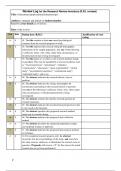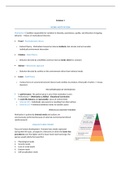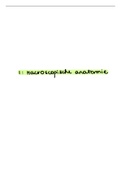Review Log for the Research Review Inventory (R.R.I. revised)
Title of document (proposal/article/manuscript): …
Author(s) surname and initials or student number: …
Rated by (your details as reviewer): …
.
Date of the review: …
Item Rate Rating item (R.R.I) Justification of your
rating
01 3 01. The title contains at least one central psychological
construct from the research proposal or study. …
02 3 02. The title indicates the research setting or demographic
information of the sample population. Any one of the following …
is sufficient: where, who, when, under what circumstances, or
the phenomenon that is being investigated.
03 1 03. The title points to, or refers to, the research method, design,
or paradigm. This may be signalled by a keyword or phrase such …
as: “lived experiences”, “perceptions”, “attitudes”,
“constructions”, “discourses”, “quasi-experimental”, “critical
study”, “psychometric properties”, “correlational study”,
“inferential study”, and so on.
04 3 04. The abstract indicates the research interest, issue or
problem. …
05 3 05. The abstract indicates the setting, demographic or
circumstances pertaining to the research interest or question. …
Any one of the following is sufficient: where, who, when, under
what circumstances, or the phenomenon that is being
investigated.
06 3 06. The abstract contains the specific research question or
research statement. …
07 3 07. The abstract indicates the key theoretical perspective(s) that
is (are) used in the literature. …
08 3 08. The abstract specifies the (proposed) research method,
study type or research design. …
09 3 09. The abstract indicates the (proposed) data collection
method. …
10 1 10. The abstract describes the (proposed) population sample,
and sampling strategy or approach. …
11 3 11. The abstract indicates the (proposed) data analysis method
or technique. …
12 3 12. For completed research projects only: the abstract
succinctly lists the actual findings of the study, and states how …
the study answers, addresses, or illuminates the research issue or
question. (Proposals will receive a “1” for this item as the actual
research has not yet been performed.)
2
, HMPYC80/2022
13 3 13. The list of keywords contains at least (a) one key
psychological construct and (b) one key reference to a …
psychological theory.
14 3 14. The list of keywords indicates the research setting and
demographic information of the sample. …
Any two of the following is sufficient: where, when, who, under
what circumstances, or the phenomenon that is being
investigated.
15 3 15. The list of keywords indicates the research method, study
type or research design. (This may be indicated directly or …
indirectly by phrases such as: “lived experiences”,
“perceptions”, “attitudes”, “constructions”, “discourses”, “quasi-
experimental”, “critical study”, “psychometric properties”,
“correlational study”, “inferential study”, and so on.)
16 3 16. The context (who, what, where, how, how come, when) of
the research issue is clearly described. …
(Note that this rating issue can be addressed anywhere in the
proposal or article, including the conclusion.)
17 3 17. The relevant role-players, affected parties or interest
groups with regard to the research issue or problem are …
mentioned. Role-players, affected parties and interest groups can
include: the researcher, individuals, clients, students,
beneficiaries, patients, families, households, communities,
practitioners, professionals, businesses, organisations,
institutions, funders, legislators, the environment (ecologies
such as a river, watershed, plant/tree/insect/animal species, or a
natural landmark); and cultural, ceremonial, or historic
practices and sites.
18 3 18. The research issue or problem is firmly located within the
discipline of psychology as indicated by appropriate …
psychological terms and constructs. (For example: perception,
attitude, cognition, emotion, experience, behaviour, discourse,
identity, community, ideology, etcetera.)
19 3 19. The interest in the problem, issue or phenomenon is
clarified. Why, how, or how come is the research topic of …
interest to the relevant role-players, affected parties or interest
groups? (See role-players mentioned in Question 17)
20 3 20. For research proposals at least 12 references from relevant
scientific and disciplinary literature are provided in the …
literature review. For research articles at least 24 references
are used in the introduction, literature review, results, and
discussion sections. (This is a minimum standard. Note that the
next 2 items explore the comprehensiveness and currency of the
literature review.)
21 2 21. A minimum of three relevant theoretical perspectives are
discussed, compared, evaluated, and integrated -- to understand, …
describe or explain the psychological dynamics of the research
issue, phenomenon and context literature are provided in the
literature review. (Theoretical triangulation). Note that older
publications of seminal theorists (for example Freud, Skinner,
Jung, etcetera) are (or may still be) relevant. Recent and
3






